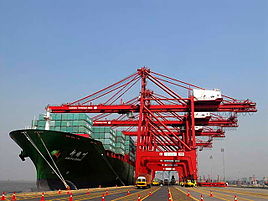Ministry of Shipping (India)
The Ministry of Shipping, a branch of the Government of India, is the apex body for formulation and administration of the rules and regulations and laws relating to shipping, headed by Shri Mansukh L. Mandaviya.
 Emblem of India | |
 Jawaharlal Nehru Port Trust | |
| Agency overview | |
|---|---|
| Jurisdiction | |
| Headquarters | Parivahan Bhavan 1, Parliament Street New Delhi 110001 28°37′9.58″N 77°12′37.29″E |
| Annual budget | ₹1,881.83 crore (US$260 million) (2018-19 est.) [1] |
| Minister responsible | |
| Website | shipmin |
Maritime transport is a critical infrastructure for the social and economic development of a country. It represents the pace, structure and pattern of development of water transport in the country. The Ministry of Shipping encompasses the shipping and port sectors which include shipbuilding and repair, major ports, national waterways and inland water transport. The ministry has been entrusted with the responsibility to formulate policies and programmes on these subjects and their implementation.[2]
History
In July 1942, the Department of Communications was split into two departments, the Department of Posts and the Department of War Transport. The Department of War Transport included major ports, railways, roads, water transport, petrol rationing and producer gas. Its functions were to manage transportation during wartime. Coastal shipping and the management and expansion of major ports were also added to the portfolio. Exports were given priority in the department.[3]
Changes over the years
After the independence of India in 1947, various governments have reorganized and renamed the department.[3]
- 1957: "Department of War Transport" was renamed as "Ministry of Transport & Communications".
- 1966: On 25 January, under President's order the "Department of Transport, Shipping & Tourism" was placed under "Ministry of Transport and Aviation".
- 1967: On 13 March, the "Ministry of Transport and Aviation" was split into two as the "Ministry of Shipping and Transport" and the "Ministry of Tourism and Civil Aviation".
- 1985: On 25 September, with the reorganization, the "Ministry of Transport and Shipping" became the "Department of Surface Transport under the Ministry of Transport".
- 1986: On 22 October, the "Department of Surface Transport under Ministry of Transport" was renamed as "Ministry of Surface Transport".
- 1999: On 15 October, "Ministry of Surface Transport" was afterwards reorganized into two as "Department of Shipping" and the "Department of Road Transport and Highways".
- 2000: On 17 November, the "Ministry of Surface Transport" was bifurcated into two different ministries as "Ministry of Shipping" and "Ministry of Road Transport and Highways".
- 2004: On 2 October, "Ministry of Shipping" and "Ministry of Road Transport and Highways" were again merged and renamed as "Ministry of Shipping, Road Transport and Highways". It had two departments; "Department of Shipping" and "Department of Road transport and Highways".
Organisational setup
- The Secretary (Shipping) is assisted by Joint Secretaries (Shipping, Ports), Development Advisor (Ports), Chief Controller of charting and other officers at the level of
directors, deputy secretaries, under secretaries and other secretariat and technical officers.[4][5]
- The Accounts wing is headed by a Chief Controller of Accounts who is inter alia responsible for accounting, payment, budget, internal audit and cash management.
- Advisor (Transport Research) renders necessary data support to various wings of the Ministry for policy planning, transport co-ordination, economic and statistical analysis on various modes of transport with which the ministry is concerned.
The following are autonomous organisations, societies and PSUs functioning under the administrative control of the ministry:
Subordinate/attached offices
- Directorate General of Shipping, Mumbai
- Andaman and Lakshadweep Harbour Works, Port Blair
- Directorate General of Lighthouses and Lightships, New Delhi
- Minor Ports Survey Organisation, Mumbai
Autonomous bodies
- Chennai Port Trust
- Cochin Port Trust
- Inland Waterways authority of India, Noida
- Jawaharlal Nehru Port Trust
- Kandla Port Trust
- Mumbai Port Trust
- National Shipping Board
- New Mangalore Port Trust
- Paradip Port Trust
- Kolkata Port Trust
- Seamen's Provident Fund Organisation, Mumbai
- Tariff Authority of Major Ports, Mumbai
- V.O.Chidambarnar Port Trust
- Visakhapatnam Port Trust
- Indian Maritime University
Societies and associations
- Indian Ports Association
- Seafarers Welfare Fund Society
PSUs
- Central Inland Water Transport Corporation Limited
- Cochin Shipyard Limited, Cochin
- Dredging Corporation of India Limited
- Ennore Port Limited
- Hooghly Dock & Port Engineers Limited
- Sethusamundaram Corporation Limited
- Shipping Corporation of India, Mumbai
- Indian Port Rail & Ropeway Corporation of India
Statistics
India currently ranks 16th among the maritime countries with a coastline of 7,517 km with 13 major ports (12 government and one corporate) and about 200 non-major ports currently operating in the western and eastern regions of the country. According to the ministry 95% of India's trade by volume and 70% by value occurs through maritime transport.[6]
Market size
Cargo traffic of Indian ports were 911.5 MT for FY12, and was projected to be around 1,758 MT for FY17. During April–May 2014 ports handled 95.87 MT of cargo as compared to 91.48 MT during April–May 2013, an increase of 4.8%, according to the data released by Indian Ports Association (IPA).
Of the major ports, Mormugao Port posted highest growth in traffic (24.48%) during April and May 2014, followed by Mumbai Port (14.35%), Kamarajar Port (13.90%), V.O. Chidambaranar Port (13.67%) and Kolkata Dock System (12.36%) as compared to the same period the previous year. In terms of volume, Kandla port led the pack with 15.31 MT of traffic handled followed by Paradip port at 11.73 MT during the same period.[7]
In 2013–14, coal cargo traffic (thermal coal and coking coal) volumes rose by 20.6 per cent to 104.5 MT from 86.7 MT a year previously. Among commodities, there was an increase of 25 per cent in handling of fertilizers in April 2014 in comparison to April 2013. Iron ore handling also showed an increase of 16.8 per cent during the month.[8]
Investments
The Indian ports sector received FDI worth US$1,635.40 million between April 2000 and May 2014, according to the Department of Industrial Policy and Promotion (DIPP), Ministry of Commerce and Industry.
The ports sector in India were awarded 30 projects in 2013-14 entailing an investment of over Rs 20,000 crore (US$3.32 billion), marking a threefold increase over the preceding year.
The following are major investments and developments in the sector:
- Adani Ports and Special Economic Zone has signed an agreement with L&T Infrastructure and Tata Steel to acquire 100% stake in DPCL for rupees 5000 crore(US$915.17 million)[9]
- JNPT and PSA have signed a concession agreement for the Port's fourth container terminal worth Rs 8,000 crore (US$1.33 billion). It currently operates container terminals in Kolkata, Tuticorin and Chennai ports, with a total capacity of 2 million twenty-foot equivalent units (TEUs). The fourth container terminal would have a capacity of 4.8 million TEUs.
- Paradip Port plans to set up hybrid cargo terminals - captive-cum-common user facility - as part of its expansion plans.[10]
- L&T Shipbuilding Ltd is diversifying its cargo handling capacity at Katupalli Port to include automobiles and oil products in addition to container handling. Originally, the Katupalli port planned to handle a total of 25 MT of cargo, of which 24 MT was containerised cargo and the rest steel and project cargo.
Government initiatives
The Government has allowed FDI up to 100% under the projects related to the construction and maintenance of ports and harbours. A 10-year tax exemption has been given to the enterprises engaged in the business of developing, maintaining and operating ports, inland waterways and inland ports.[11]
The Minister for Road Transport, Highways and Shipping Nitin Gadkari said that his ministry will coordinate with other ministries of Environment & Forests, Tourism, Power and Water Resources, River Development and Ganga Rejuvenation for development of transport and tourism along the river Ganga.[12]
The Cochin Steamer Agents Association (CSAA) will take the lead to improve the cargo throughput by organising marketing initiatives in the hinterland in association with the port management, terminal operator and various other stakeholders. A 20 per cent growth target in container volume was fixed for 2014–15.
The National Maritime Agenda 2010-2020[13] is an initiative of the Ministry of Shipping to outline the framework for the development of the port sector. The agenda also suggests policy-related initiatives to improve the operating efficiency and competitiveness of Indian ports.
Sagar Mala project is the new initiative of the ministry.
Future plans
Investments and cargo traffic represent the health of the port services, these include operation and maintenance services such as pilotage, harbouring and provision of marine assets like bargers and dredgers. The Planning Commission of India in its 12th Five Year Plan expects a total investment of Rs 180,626 crore (US$30.05 billion) in the ports sector.[14]
Through its Maritime Agenda 2010–2020, the Ministry of Shipping has set a target capacity of over 3,130 MT by 2020, largely through private sector participation. More than 50 per cent of this capacity is expected to be created at non-major ports.[15]
Visakhapatnam port looked forward to a bright year in 2014–15, as several development projects were on the verge of completion, and the port expected to handle 65 MT of cargo during the year.[16]
Ministers
- Arun Jaitley (7 November 2000 - 1 September 2001)
- Ved Prakash Goyal (1 September 2001 - 29 January 2003)
- Shatrughan Sinha (29 January 2003 - 22 May 2004)
- K. Chandrasekhar Rao (23 May 2004 - 25 May 2004)
- T. R. Baalu (25 May 2004 - 3 September 2004)
(Ministry was merged with Road Transport and Highways) - G. K. Vasan (28 May 2009 – 26 May 2014)
- Nitin Gadkari (26 May 2014 – 26 May 2019)
- Mansukh L. Mandaviya (31 May 2019 - Incumbent) (MoS, Independent Charge)
See also
References
- "Budget data" (PDF). www.indiabudget.gov.in. 2019. Archived from the original (PDF) on 4 March 2018. Retrieved 15 September 2018.
- India, Ministry of Shipping, Government of. "Ministry of Shipping, Government of India". shipping.nic.in. Retrieved 30 August 2016.
- "Organisational History". Organisational History. Ministry of Shipping, Government of India. Archived from the original on 21 July 2014. Retrieved 2 October 2014.
- "Organisational Setup". Organisational Setup. Ministry of Shipping, Government of India. Archived from the original on 20 July 2014. Retrieved 2 October 2014.
- "Flow Chart of setup" (PDF). Flow Chart. Ministry of Shipping, Government of India. Retrieved 2 October 2014.
- "Maritime Statistics". Indianbusiness.nic.in, Government of India. Archived from the original on 6 October 2014. Retrieved 2 October 2014.
- "Road Ahead". Indiabusiness.nic.in, Government of India. Archived from the original on 6 October 2014. Retrieved 5 October 2014.
- "Ports in India". Indian Brand Equity Foundation. Retrieved 6 October 2014.
- "Adani Strikes: Acquisition of Dharma Port". The Economic Times. 16 May 2014. Retrieved 2 October 2014.
- "Paradip ports offers hybrid ports". The Hindu. 8 June 2014. Retrieved 2 October 2014.
- "Government Initiatives". Indianbusiness.nic.in, Government of India. Archived from the original on 6 October 2014. Retrieved 2 October 2014.
- "Ports in India". IBEF. Indian Brand Equity Foundation. Retrieved 2 October 2014.
- "Maritime Agenda 2010-2020". Ministry of Shipping, Government of India. Archived from the original on 20 July 2014. Retrieved 2 October 2014.
- "12th Five Year Plan (2012-2017)" (PDF). Planning Commission, India. Archived from the original (PDF) on 7 October 2013. Retrieved 2 October 2014.
- "PPP in the Agenda" (PDF). Ministry of Shipping, Government of India. Archived from the original (PDF) on 6 October 2014. Retrieved 2 October 2014.
- "Bright future for Vizag". The Hindu Business. The Hindu. 7 April 2014. Retrieved 2 October 2014.